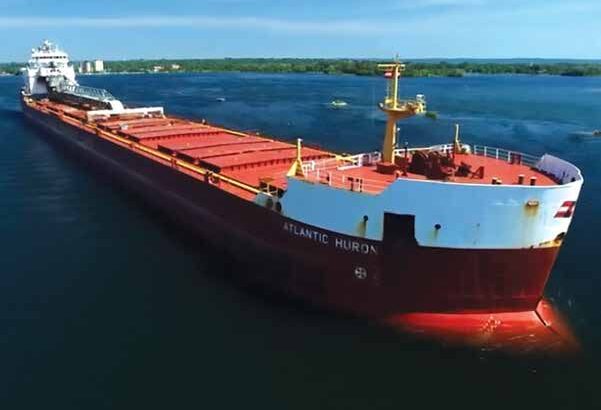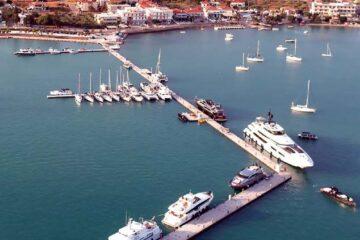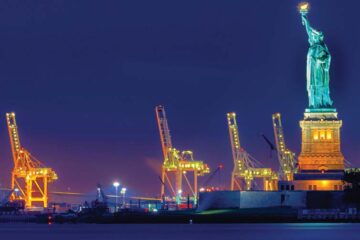NTSB Accident Brief
On July 5, 2020, about 0250 local time, the self-unloading bulk carrier Atlantic Huron was transiting the Upper St. Marys River, west of the Soo Locks, in Sault Sainte Marie, Michigan, with a crew of 25. While on approach to the locks and attempting to slow, there was a propulsion problem involving the vessel’s controllable pitch propeller (CPP) system. The vessel subsequently contacted the west center pier at 6.8 knots. Before reaching the lock gate, the vessel’s motion was halted, and the crew moored the vessel to the pier. No pollution or injuries were reported. Damages to the vessel ($1,633,000) and pier ($573,000) were estimated at $2.2 million.
All miles in this report are nautical miles (1.15 statute miles).
BACKGROUND
The 736-foot-long Atlantic Huron was built in Ontario, Canada, in 1984. The Canadian-flagged bulk carrier was owned by Canadian Steamship Lines (CSL). It operated on the inland waters of the St. Lawrence Seaway and the Great Lakes, transporting a range of products, including iron ore, coal, stone, and salt, between ports in the United States and Canada. The vessel was propelled by a single non-reversing, slow-speed, direct-drive diesel engine that was coupled to a drive shaft and CPP. The CPP allowed the vessel to move ahead or astern without changing the direction of the shaft. In a CPP, the blades are not fixed in position but are fastened to the hub in a way that allows them to rotate and thereby change pitch. The blade pitch determines both the vessel’s speed and its direction (forward or astern) through the water.
The Soo Locks are located on the U.S. side of the St. Marys River in Sault Sainte Marie, Michigan. Made up of two sets of parallel locks running east and west, they are owned, operated, and maintained by the US Army Corps of Engineers. The set of locks to the north is accessed via the North Canal, and the more frequently used set of locks to the south is accessed via the South Canal. The two canals are separated by a center pier that extends away from the locks several thousand feet east and west. The center pier is equipped with mooring bollards, which allow vessels to tie up to the pier while waiting to transit the locks. The south channel is serviced by two locks: the Poe Lock to the north and the MacArthur Lock to the south.
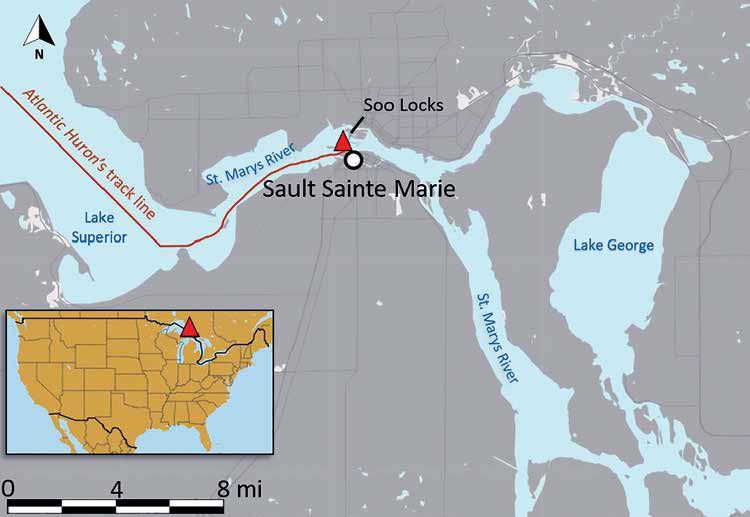
ACCIDENT EVENTS
At 0720 on July 4, 2020, after completing cargo discharge operations, the Atlantic Huron departed Thunder Bay, Ontario, Canada, bound for Meldrum Bay on the northwest shores of Manitoulin Island in Lake Huron, Canada. Transiting with empty cargo holds, the vessel with its crew of 25 sailed east across Lake Superior. En route to its destination, the vessel was scheduled to navigate the St. Marys River, which included a passage of the Soo Locks. At 0048 the next morning, the Atlantic Huron approached the entrance of the St. Marys River. In preparation for arrival at the locks, the second mate, who was in charge of the navigational watch at the time, completed the required tasks contained in the “Arrival Checklist.”
The checks included steering gear and steering gear alarm tests, internal communications checks, and a requirement to confirm ahead and astern operation of main propulsion machinery. Shortly after completing the checklist, the second mate logged that the vessel’s two bow anchors and single stern anchor were clear. He also notified the engineer on watch that they were approaching the river’s entrance.
Pilotage of a vessel on the Great Lakes and St. Lawrence Seaway required special training and certification from the Great Lakes Pilotage Authority. Both the captain and the second mate of the Atlantic Huron were certified to pilot the vessel and possessed valid Canadian mariner credentials. For vessels of the Atlantic Huron’s size, regulations further required the master to be on the bridge and an engineering watch officer in the engine room while transiting the Soo Locks. In addition, a mate and able seaman were required to be on watch and available to assist, and the chief engineer was required to be available (but not necessarily on watch).
At 0110, in preparation to transit the river and locks, the second mate verified the engine room was manned. Twenty minutes later, he called and woke the captain in his stateroom.
At 0150, the captain, who had arrived on the bridge, assumed navigational control (the conn) of the Atlantic Huron as it transited the river. The captain stated that “the weather was great,” and there were “5 or 6 miles” of visibility.
Typically, when transiting the locks, several of the vessel’s deck crew were transferred to the pier to assist with tying up the vessel. The remainder of the deck crew were situated forward and aft, near the vessel’s mooring winches. The second mate exited the bridge and reported to the stern to oversee the deck crew during the locks transit.
At 0245, the captain slowed the Atlantic Huron and allowed the vessel to “coast” toward the South Canal and the west center pier, where he intended to land the vessel and slide it up the pier wall toward the locks. As the vessel’s speed reduced to 3.8 knots about 0.5 miles from the end of the west center pier, the captain ordered full astern to slow the vessel further. At this point, the captain noticed that the CPP pitch indicator was “erratic,” fluctuating from full ahead, to full astern, to zero, and then back to full astern. He also received a pitch differential, propeller pitch from the helm station did not match the propeller’s actual pitch. Using the shipboard telephone, he called the engine control room (ECR) to report the inconsistent pitch indicator.
The engineer on watch (EOW) was not aware of any abnormalities with the pitch indicator and had not received any system alarms from the CPP or associated equipment. The pitch indicator located in the ECR was indicating full astern, which matched the order from the bridge. The captain instructed the EOW to phone the chief engineer and have him report to the engine room to investigate the issue. After calling the chief engineer, the EOW looked out the ECR door and observed the oil distribution (OD) box shifting forward and backward.
Moments later, with the astern pitch command still in place and the bridge pitch indicator now showing full astern, the captain noticed the vessel’s speed ahead increase. The captain again called the ECR. The EOW could not explain why the vessel was speeding up and informed the captain that the chief engineer was on his way down to the engine room. After hanging up, the captain called the Soo Locks control station on the radio and informed the lockmaster that he had an issue with his vessel’s “pitch.”
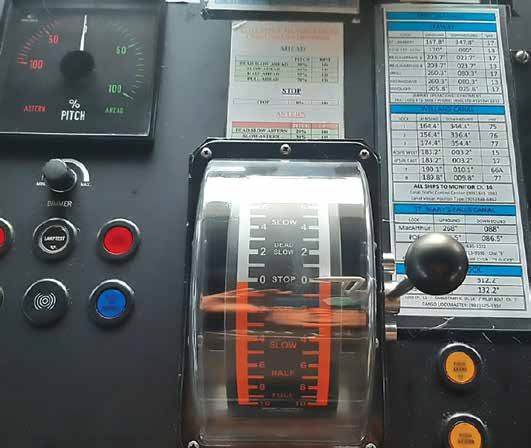
Soon after the EOW hung up the phone with the captain, the chief engineer arrived in the ECR. The EOW quickly explained to the chief engineer what the captain was reporting, and the two of them exited to investigate. In an attempt to verify the propeller pitch and potentially alter the pitch manually, the chief engineer and EOW went to the CPP control valve assembly in the lower engine room.
The control valve assembly was mounted atop the system’s OD box. Normally, the OD box sat on the shaft with bearings, and a “torque stay,” or locking pin, prevented the box from rotating. The chief engineer discovered that the OD box assembly had rotated on the drive shaft and was no longer retained by the torque stay.
At 0248, as the engineers investigated the OD box and control valve assembly issues in the lower engine room, the Atlantic Huron continued to pick up speed. The propeller pitch order from the helm remained at full astern. A main engine emergency stop push button was available on the bridge but was not activated. Having not yet heard from the chief engineer, the captain announced on the vessel’s public address system for the chief engineer to call the bridge “immediately.” With the vessel’s speed now having increased to about 6.5 knots, the captain sounded the general alarm and ordered the second mate to drop the stern anchor. The second mate let out about 130 feet of chain and set the brake.
As the distance to the pier closed to less than 600 feet and the vessel’s speed continued increasing to 7.1 knots, the captain let go the two bow anchors remotely from the bridge. About the same time, the chief engineer called the captain from the ECR. He reported that the OD box had experienced a failure and that the main engine had to be shut down to stop the shaft from rotating. With approval from the captain, the chief engineer stopped the main engine from the ECR.
The brakes were applied to the bow anchors. The port anchor brake held with about 5 shots (450 feet) paid out; the starboard anchor brake did not hold, and the anchor paid out to and held at the bitter end. With the port anchor brake set, the vessel “sheered” to port toward the west center pier. In an attempt to avoid contact with the pier, the captain steered the vessel hard to starboard and used the bow thruster to thrust away from the pier.
At 0250, the Atlantic Huron’s port bow contacted the Soo Locks’ west center pier at 6.8 knots. With the engine now stopped, the vessel began to slow as it slid alongside the pier. The captain used the bow thruster to push the vessel up against the pier.
The deck crew then managed to transfer personnel to shore and, together with the crew on board the vessel, they stopped the vessel and secured it to the pier.
ADDITIONAL INFORMATION
Drug and alcohol testing of the captain and vessel’s crew associated with the accident was completed. All results were negative. The captain’s work and rest log for the 6 days before the accident (the captain joined the vessel on June 30) indicated that he had more than 11 hours of rest each of those days.
CPP and Prior Issues. The propeller pitch was altered by means of high-pressure hydraulic fluid acting on a piston located within the propeller hub. Two dedicated hydraulic pumps in the engine room supplied pressure to the system, and the flow of oil was controlled via the valve assembly above the OD box at the forward end of the shaft in the engine room. The valves could be operated remotely from the bridge and ECR, or locally at the control valve assembly. Hydraulic oil controlled by the name implies, the oil would then be distributed through ports on the shaft’s circumference into an oil transfer tube that ran within the drive shaft to the piston within the propeller hub to rotate the blades.
The transfer tube had inner and outer pipes through which ahead and astern oil passed. As hydraulic pressure moved the piston ahead and astern to achieve the desired pitch, this axial movement was transferred from the piston and tube to a mechanical follow-up mechanism, which provided feedback to the control valve assembly and supplied corresponding pitch indication feedback via a local gauge and other gauges in the ECR and bridge.
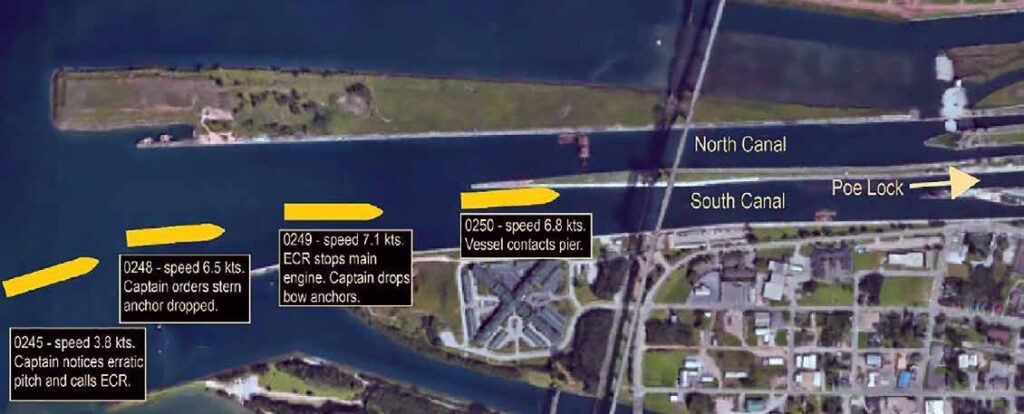
Nine days before the accident, on June 26, the Atlantic Huron was under way, loaded with iron ore when, in an attempt to slow the vessel to avoid rain squalls, the (non-accident transit) captain gave an astern pitch command. The propeller pitch did not respond as desired but instead went to full ahead.
The crew stopped and secured the main engine and anchored the vessel in open water. Third-party technicians from a marine service company later discovered that a bearing within the feedback mechanism arrangements of the CPP’s OD box had come out of position and jammed against the feedback arm. This caused the arm to deflect “in such a way that it [the CPP pitch] went full ahead and seized in that position.” They also discovered that the OD box was able to move axially on the shaft an “inch or more.” They concluded that this movement was caused by a worn torque stay.
To alleviate the issues, the technicians freed up components that had become jammed, replaced the bearing that had come out of position, and checked the propeller pitch feedback arm for damage. They also temporarily shimmed the torque stay and recommended that, while shimmed, the propeller pitch should be limited to 75 percent to prevent failure.
Once repairs were complete, a surveyor from the vessel’s classification society, Lloyds Register, boarded the vessel to witness a function test. A short sea trial was completed, and the CPP and OD box performed satisfactorily with no issues reported. The class surveyor allowed the vessel to proceed with a “condition of class” requiring that the torque stay be repaired within a month. “Conditions of class” are temporary arrangements issued by a classification society that allow a vessel to operate with a deficiency for a limited time period.
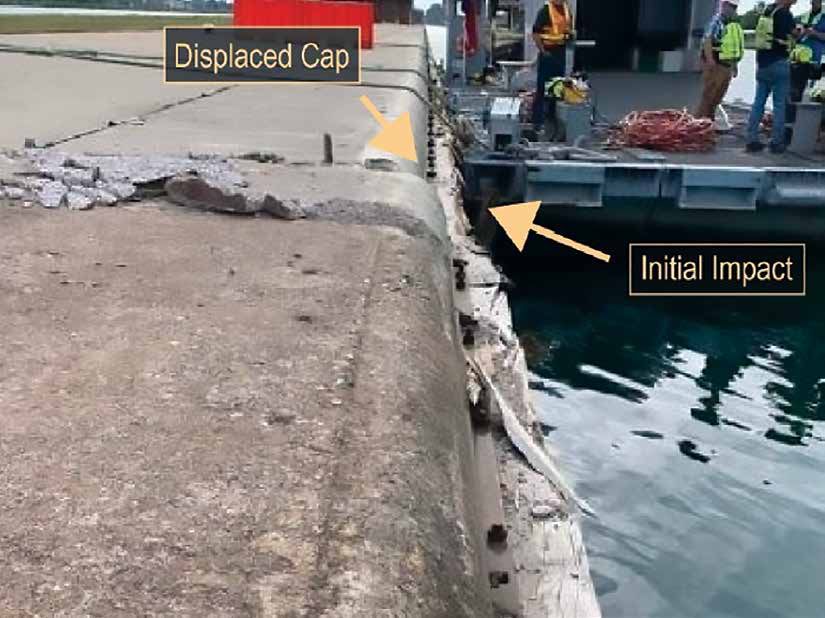
Three days later, on June 30, machinists returned to the vessel and installed a new torque stay, removing the shims that had been in place. With the new torque stay installed, the previous pitch limitation recommendation was lifted, allowing the vessel to operate normally. The class surveyor inspected the repair and deemed it acceptable in the short term but required that the “operating clearance between pin [torque stay] and hole be reinstated” by April 2021. From the time the Atlantic Huron received the repair of the OD box torque stay on June 30 until the accident on July 5, the vessel completed three docking/undocking evolutions and an upbound transit of the Soo Locks, all without any issues from the CPP or OD box.
ANALYSIS
As the vessel approached the lock piers, a failure of the CPP system’s OD box and control valve assembly caused a full ahead pitch on the propeller blades when the captain ordered an astern pitch to slow the vessel. Additionally, because the feedback mechanism designed to provide pitch indication to watchstanders on the bridge and in the ECR failed, those indicators would have shown the ordered astern pitch. The manner in which the OD box failed, giving the captain an erroneous propeller pitch indication, combined with the EOW not being able to immediately explain why the vessel was speeding up, delayed the captain’s decision to secure the main engine.
The captain could have stopped the main engine to slow the vessel’s speed once he noticed the erratic operating pitch indicator accompanied with an increase in the vessel’s speed, and before deploying the anchors. If the vessel’s main engine had been stopped when the failure to the OD box occurred or shortly after, the vessel’s speed would not have increased from 3.8 knots to 7.1 knots. It is also likely that if the vessel’s anchors were deployed at that time, given the approximate 0.5-mile distance from the end of the pier, the vessel would have been able to stop before contacting the pier.
However, given the relatively short period in which the accident unfolded and the limited time that remained before contact, after contacting the EOW, the captain focused on reaching the chief engineer to diagnose the problem. The captain had to monitor his position (focusing on visual cues, as would be expected in a critical phase of the operation) and control station gauges, detect the propulsion issue, and then come up with a solution—which, in a stressful scenario, may be less likely to occur.
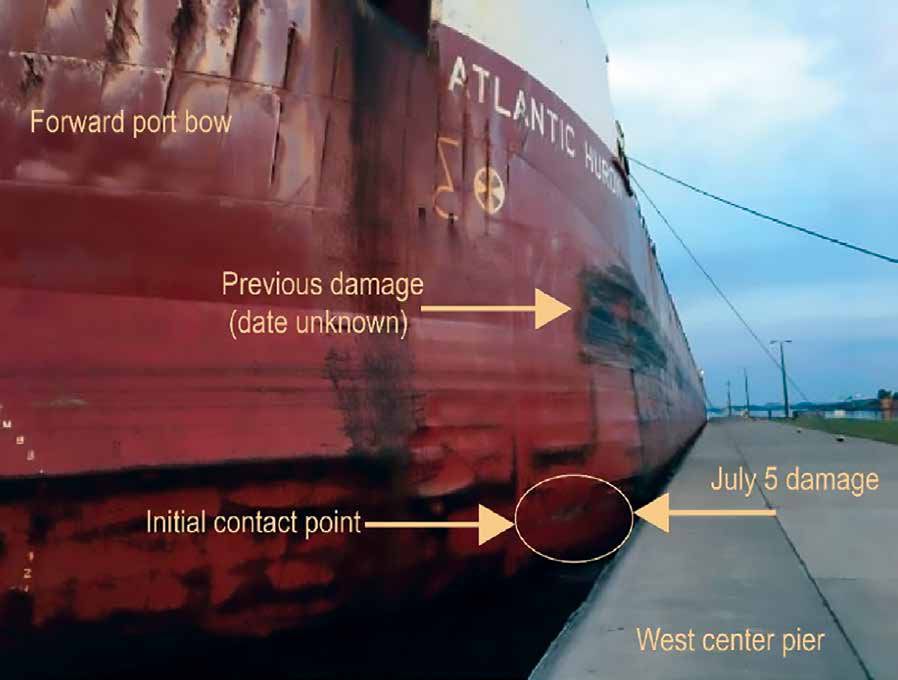
Part of an SMS should address potential emergency shipboard situations, including loss of propulsion, collision, and contact, and establish ways to respond to them. If the company provided an SMS vessel-specific policy pertaining to the loss of propeller pitch control, crewmembers trained in and familiar with the policy would be better prepared to act quickly and, in this accident, may have been more apt to stop the main engine.
The damage to the OD box feedback mechanism that occurred during a previous voyage on June 26 likely was caused by the same underlying mechanical issue that eventually resulted in the total failure of the unit on July 5. However, since the damage from the initial incident was not severe, and the repairs that were made alleviated the problem, it is understandable that the technicians and shipboard engineers did not discover the underlying problem, since repairs did not require disassembly of the OD box. Because the repairs were minor, and a successful sea trial was conducted under the supervision of a class surveyor, the vessel’s crew and CSL management justifiably believed that the CPP and OD box systems were operating properly prior to the accident.
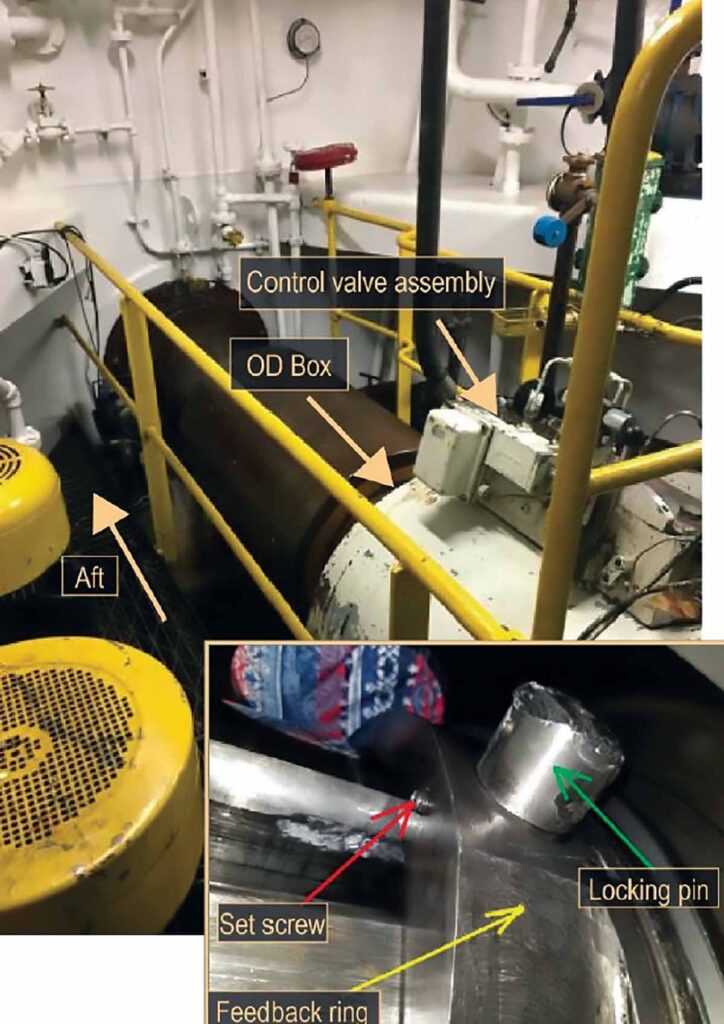
The set screw designed to secure the feedback ring locking pin was required by the original equipment manufacturer to have thread-locking fluid applied when installed; this requirement was clearly indicated on system schematics. Vessel maintenance records show that this set screw was last removed and reinstalled over 4 years before the accident, during a shipyard period. When the set screw was examined post-accident, technicians found no evidence that thread-locking fluid had been applied. As a result, the set screw and then subsequently the locking pin were both able to back out.
PROBABLE CAUSE
The National Transportation Safety Board determined that the probable cause of the contact between the Atlantic Huron and the west center pier at Soo Locks was not following the manufacturer’s requirement to use thread-locking fluid during installation of the feedback ring locking pin set screw on the vessel’s controllable pitch propeller system, which led to the failure of the controllable pitch propeller’s oil distribution box. Loss of propulsion control in a critical phase of operation demands crewmembers act quickly to mitigate potential accidents. Part of a safety management system should address potential emergency shipboard situations, including loss of propulsion, collision, and contact, and establish ways to respond to them. Due to their unique blade control, vessels with controllable pitch propellers should have specific procedures for loss of engine and loss of pitch control. These emergency procedures should be well understood and practiced by crewmembers both on the bridge and in the engine room.






